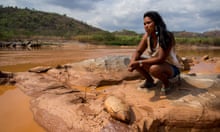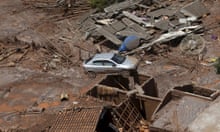The recent collapse of a mining dam in the Brazilian state of Minas Gerais is one of the biggest environmental disasters in the country’s history. Apocalyptic images of communities swallowed by mud and a river flooded by mining waste have shocked a population that has become hardened to tragedy.
Between 40-62m cubic metres of the water and sediment from iron ore extraction sluiced down a mountainside more than two weeks ago when the Fundão tailings dam failed at an open-cast mine operated by Samarco, a joint venture between mining giants BHP Billiton and Vale.
Concern that two further dams may yet collapse – one of which ruptured during the accident – suggests the unfolding tragedy may yet worsen.
What caused the dam to burst remains unclear but there are suggestions this was an avoidable catastrophe, the result of lax safety regulation in the Brazilian mining industry. Prosecutors have already alleged negligence. Carlos Pinto, who leads a team of environmental prosecutors for the state of Minas Gerais which is investigating the tragedy, said: “Negligence means the absence of the due care in the operation or monitoring of the dam”.
An environmental report produced by the environmental institute Instituto Prístino and commissioned in advance of the state’s 2013 decision to allow Samarco to increase the dam’s height raised concerns over its safety and recommended monitoring, a contingency plan and a “dam break analysis”.
Samarco said its three dams in the complex – including the one that burst – had their appropriate licences. According to the company, the institute’s recommendations were being taken on board.
BHP Billiton has agreed an external investigation with Vale and is reviewing all its tailings dams. Vale, which has now revealed it had been storing waste from a nearby dam in the Fundão dam (amounting to less than 5% of the total, it says), has checked all its tailings dams.
The human and environmental cost
Twelve people are dead and 11 still missing (including eight Samarco workers) in the “sea of mud” which oozed into one of Brazil’s most important rivers, the Rio Doce, killing fish and aquatic life hundreds of kilometres away and making the water hundreds of thousands of people depend on undrinkable.
More than 500 people remain homeless, housed in hotels or with relatives. The community of Bento Rodrigues, closest to the mine, may never be habitable again.
“My house does not exist any more,” said Angelica Peixoto, 50, a teacher from the small community of Paracatu which was also destroyed. Her family of five lost everything.
The disaster left Governador Valadares, a city of 278,000 downstream from the mine site that depends on the Rio Doce for its water, without supplies for a week. “There are a lot of rumours that the water is contaminated,” Érico Netto, a 41-year-old doctor in the city, told the Guardian. “I’m drinking mineral water for now.”
Indigenous people from the Krenak tribe living beside the river blocked a railway line run by Vale in protest at the destruction caused. The line has since been freed. Meanwhile the sea of mud has reached the sea.
A chaotic response
The mining companies involved, as well as Brazil’s politicians, initially struggled to stay on top of the fast-moving situation and the public has condemned the disaster and its handling. Last week, 300 activists stained the front of Vale’s Rio headquarters with mud.
Vale was slammed for initially reacting with a short press release the day after the tragedy. CEOs of Vale and BHP Billiton visited the site six days after the collapse and promised full support and resources.

On the night of the tragedy, Samarco’s CEO Ricardo Vescovi released a video on Facebook saying: “We are very dismayed by what happened but we are absolutely mobilised to contain the damages caused by this tragic accident”. Samarco said it has 600 people working along the affected area, liaising with victims, helping those made homeless and supplying drinking water.
Brazil’s president, Dilma Rousseff, herself heavily criticised for waiting a week to visit the disaster area, has announced an initial 250m reals (£43.5m) in fines for Samarco, one of Brazil’s biggest mining companies.
Samarco has also been suspended from operating in the state of Minas Gerais and had 30m reals (£5.2m) of its funds blocked by a judge in Mariana to repair damage caused in the area. It agreed an initial 1bn reals (£174m) in compensation and preventative measures with prosecutors. But Pinto said costs will be much higher.
“You can’t measure the values yet, the dimension, the proportion of this damage,” he said. “It is still very premature to appoint a specific cause but we have ruled out mischance or a mere accident.”
In a sombre teleconference with analysts on 16 November, Vale said it was focused on its efforts to help with damage and human impact, which include delivering millions of litres of water to those affected. The company said the civil damages will be more than Samarco’s insurance cover.
Was this a preventable tragedy?
Perhaps the biggest doubts hang over the causes of the tragedy, which are still being investigated. The dam that burst and the dam that ruptured were earthwork structures holding a mix of water and extraction waste.
Many modern mines use safety techniques such as radar and laser monitoring which should have warned of any structural problems, said John Tumazos, an independent mining analyst and consultant in New Jersey.
Samarco said that it monitored with drones, piezometers, water level gauges, surface marks, bi-weekly and daily checks. “None of the above controls indicated anomalies in the dams,” a spokesperson for the company said.
Fingers are also being pointed at government. The state of Minas Gerais has suffered five dam breaks in the last decade. “We have to revise our safety criteria,” said Marilene Ramos president of the Brazilian government’s environment agency Ibama.
Officials in Minas Gerais rated the Fundão dam as Class III - its highest level for potential to cause environmental damage. In addition to the independent report produced by Instituto Prístino, Samarco provided its own independent report in July 2015. Produced by a company called VOGBR, it judged the dam as safe. A spokeswoman for the state Secretariat of the Environment said Secretariat inspectors visited the dam in October 2014 and considered it to be safe, but they are not engineers, she said.
The National Department of Mineral Production, the federal body responsible for checking the safety of tailings dams, did not visit the dam because it was considered low risk, one of its inspectors told the G1 news site.
Pinto said this self-monitoring system does not work. “It is not possible for a dam to be that safe and a few months later have a disaster of this magnitude,” he said.
Minas Gerais has created a task force to study alternatives for storing mining waste. Brazil’s Senate has decided to create a temporary commission to review dam safety legislation - a new mining code has been stuck in Congress for years.
Angelica Peixoto and her husband knew there was a reservoir in the hills above the village where they built their house, but had no idea of its size, or potential danger. “If we had known this we wouldn’t have put the house there,” she said.







Comments (…)
Sign in or create your Guardian account to join the discussion